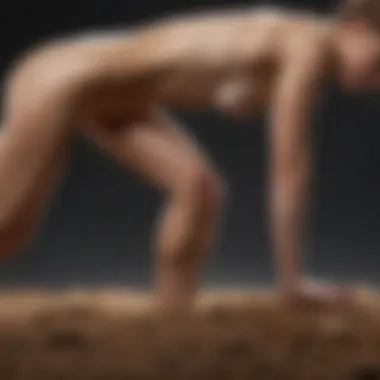Understanding Camptocormia: A Comprehensive Analysis


Research Overview
Camptocormia is a condition that significantly impacts an individual's posture and quality of life. Characterized by an abnormal forward bend of the trunk, camptocormia presents unique medical challenges. Understanding the etiology of this disorder is crucial for effective diagnosis and treatment. Recent research sheds light on the neurological and muscular underpinnings of the condition, primarily focusing on connections to parkinsonian syndromes and various neurological disorders. This overview serves to present the key findings of contemporary studies and contextualize the issues surrounding camptocormia.
Summary of Key Findings
Research has identified several significant points related to camptocormia that are essential for both clinical practitioners and patients:
- Etiology: The condition may arise from multiple factors including neurological disorders, muscular dystrophies, or even psychological conditions.
- Diagnosis: Diagnostic processes often involve thorough neurological examinations and imaging techniques to rule out associated disorders.
- Treatment Options: Current treatments vary from physical therapy and medications to surgical interventions, depending on the underlying causes.
- Psychosocial Impact: Camptocormia goes beyond physical limitations; it also affects mental health and social interactions, creating additional layers of complexity in management.
Background and Context
The understanding of camptocormia is evolving. Historically, it was not well recognized, and many cases were misdiagnosed or overlooked. Recent advancements in both neuroscience and psychology provide a clearer picture of how the condition impacts individuals both physically and mentally. For instance, there is increasing emphasis on the psychological aspects of living with camptocormia, which can include anxiety and social isolation. This comprehensive analysis aims to blend medical understanding with social implications, which are equally critical.
Methodology
A holistic approach is essential for studying camptocormia, which necessitates analyzing both clinical and psychosocial aspects. Current methodologies in researching this condition tend to be multi-faceted, involving both qualitative and quantitative techniques.
Experimental Design
Most studies engage in a retrospective analysis of patient records, combined with prospective investigations that follow patients experiencing trunk bending. Using standardized assessment scales helps in quantifying the severity and impact of the condition.
Data Collection Techniques
Data collection in studies on camptocormia involves a variety of techniques, including but not limited to:
- Surveys: Gathering subjective reports from patients regarding their experiences and challenges.
- Clinical Assessments: Conducting physical examinations to observe trunk angles and possible movement disorders.
- Imaging Studies: MRI and CT scans are employed to investigate any underlying neurological or anatomical issues contributing to the disorder.
Collectively, these methods provide comprehensive data that can help illuminate the complexities of camptocormia, allowing for improved diagnostics and treatment protocols.
Intro to Camptocormia
Camptocormia represents a unique clinical entity, essentially defined by the abnormal forward bending of the trunk. This condition not only affects physical mobility but also poses significant implications for psychosocial well-being. Understanding camptocormia is essential for healthcare professionals, researchers, and caregivers who encounter patients with this disorder. Knowledge of its characteristics aids in prompt diagnosis and management, ultimately enhancing patient quality of life.
As we delve deeper into camptocormia, we can uncover the multifaceted nature of this condition. From its definition to the pathophysiological mechanisms underlying its occurrence, every facet contributes to a broader understanding of how this ailment impacts individuals and society as a whole. Furthermore, an analysis of the historical context helps illuminate how medical perceptions and approaches to treatment have evolved.
This section is fundamental because it establishes the groundwork for subsequent discussions. By clarifying the definition and detailing the historical evolution of camptocormia, readers gain a robust framework that contextualizes more intricate topics such as the pathophysiology, clinical features, and potential treatment options. Thus, addressing camptocormia is not simply an exploration of a medical anomaly, but a necessary endeavor that amalgamates clinical knowledge with the lived experiences of those affected.
Definition and Characteristics
Camptocormia is defined primarily by a significant flexion of the spine, leading to a characteristic forward hunching posture. In clinical scenarios, this condition manifests as a noticeable posture change, particularly when individuals are in an upright position. The severity of the trunk bending can vary, but it often becomes more pronounced when the individual is standing compared to when sitting. The prevalence of this condition is notably higher in certain populations, especially those with underlying neurological disorders.
The primary characteristics of camptocormia include:
- Trunk Flexion: The bent posture is the hallmark of camptocormia. This flexion can impede mobility and result in discomfort or pain.
- Variability in Postural Changes: Camptocormia can be consistent or can fluctuate depending on various factors, including fatigue and the individual’s emotional state.
- Association with Other Conditions: This condition frequently accompanies other neurological disorders, such as Parkinson’s disease or dystonia, complicating both diagnosis and management.
Historical Perspective
Historically, camptocormia has been described in various texts, but it was not until the late 20th century that its recognition as a distinct medical condition gained traction. Initial descriptions were often vague and associated incorrectly with purely muscular or psychiatric issues. As medical understanding evolved, clinicians started to appreciate its neurological underpinnings and psychosocial implications.
In the early studies, there were limited treatment options explored, primarily focusing on managing the symptoms rather than addressing the root causes. However, with advancements in imaging technologies and neuroscience, the understanding of the condition has shifted considerably. Treatment modalities have also diversified, transitioning from exclusively pharmacological approaches to incorporating physical therapy and surgical interventions as potential options.
The historical narrative of camptocormia illustrates the importance of continued research and awareness. Understanding its evolution is crucial for implementing effective intervention strategies and improving patient outcomes. This background sets the stage for a more comprehensive analysis of current insights into the pathophysiology, treatment options, and social impacts of camptocormia.
Pathophysiology of Camptocormia
The pathophysiology of camptocormia is crucial in understanding this condition's complexity. It encompasses various neurological and musculoskeletal factors that interact to produce the characteristic trunk flexion. Knowing these mechanisms can aid in timely diagnosis and effective treatment options. This section will explore the neurological underpinnings and musculoskeletal contributions that shape camptocormia.
Neurological Underpinnings
Camptocormia often emerges from neurological disorders that disrupt the normal functions of the nervous system. These disorders can affect motor control, leading to abnormal posturing. Conditions such as Parkinson’s disease, multiple sclerosis, or other related neurological problems have been associated with camptocormia.
Research suggests that the neuronal circuits responsible for voluntary movement become impaired. This impairment results in a loss of postural control. The basal ganglia, a group of nuclei in the brain associated with movement, play a significant role in this condition. Dysregulation in these circuits leads to an inability to maintain an upright posture, contributing to the forward bending of the trunk.
Studies have indicated that patients may exhibit specific patterns of muscle activity, which are not coordinated properly due to neurological impairment. Identifying these patterns can facilitate targeted interventions. For example, treatments addressing these neurological elements may help restore some degree of postural alignment.
Musculoskeletal Contributions
The musculoskeletal system also significantly influences camptocormia's pathophysiology. Changes in muscle tone, strength, and flexibility can exacerbate the condition. Muscle weakness, particularly in the abdominal and back regions, affects stability and posture.
Moreover, alterations in spine biomechanics due to muscle imbalances can further compound the problem. Some individuals may develop adaptive postures to compensate for weakness, which can lead to a cycle of worsening symptoms.


Research into the structural changes in the spine is necessary. Imaging studies, such as MRI, can reveal whether there are any anomalies that may contribute to the condition. Early detection allows for interventions that could potentially slow the progression of musculoskeletal health decline.
Understanding these pathophysiological factors is essential for developing effective preventive strategies and interventions aimed at improving the quality of life for individuals affected by camptocormia.
Addressing the neurological and musculoskeletal aspects together offers a holistic approach to treatment. It is important to recognize that every patient may present with unique features in their pathophysiology, making personalized assessment and intervention vital.
Epidemiology and Demographics
The epidemiology and demographics of camptocormia are crucial for understanding its impact and relevance in healthcare. Knowledge in this area helps in identifying affected populations and tailoring interventions. This section provides insights into prevalence rates and risk factors, which foster informed research and potential therapeutic strategies.
Prevalence Rates
Studies on camptocormia indicate that its prevalence is not uniformly reported, which complicates the understanding of its overall impact. Evidence suggests that it predominantly affects adults, particularly those with certain neurological disorders. Many studies show that the condition may be underdiagnosed due to the variability in its presentation.
- In a clinical setting, estimates suggest a prevalence of about 2% to 5% among Parkinson's disease patients.
- For individuals with multiple system atrophy, the prevalence can rise, reported at approximately 10% to 20%.
The lack of comprehensive epidemiological data highlights the need for better reporting mechanisms and awareness among healthcare professionals. This will contribute to a clearer understanding of the condition's impact on specific populations.
Risk Factors
Identifying risk factors for camptocormia is essential for developing prevention strategies and guiding early diagnosis. Various factors contribute to the onset of this condition. Some established risk factors include:
- Age: Older individuals demonstrate a higher likelihood of developing camptocormia, often related to the degeneration of musculoskeletal structures.
- Neurological Disorders: Patients diagnosed with conditions such as Parkinson's disease, multiple system atrophy, and amyotrophic lateral sclerosis are notably at risk.
- Sedentary Lifestyle: Limited physical activity may also exacerbate musculoskeletal issues, leading to trunk bending.
- Psychological Factors: Anxiety and depression have potential influences, with some research indicating a correlation between mental health disorders and increased severity of symptoms.
Understanding these risk factors can assist in developing targeted prevention measures and improving management strategies for those affected.
"Epidemiological understanding provides the groundwork for better diagnosis and innovative treatment approaches for camptocormia."
Overall, integrating knowledge about the epidemiology and demographics of camptocormia into clinical practice can enhance outcomes for patients and lead to a more profound understanding of this complex condition.
Clinical Features and Diagnosis
Understanding the clinical features and diagnosis of camptocormia is essential in identifying this condition and establishing a proper treatment plan. This section delves into symptoms, diagnostic criteria, and how specific features distinguish camptocormia from other similar conditions. The importance is not only clinical but also affects the quality of life for patients. By mastering diagnosis, professionals can enhance patient outcomes.
Symptoms Presentation
The symptoms of camptocormia primarily involve a marked forward bending of the trunk, especially when standing. This abnormal posture can result in significant limitations in mobility and daily activities. Patients typically describe the position as a persistent flexion of the spine, which may improve when seated. Other associated symptoms may include:
- Discomfort or pain in the back
- Fatigue related to muscle strain from holding a non-ergonomic posture
- Feelings of self-consciousness due to the visible posture
Noteworthy is that the severity of the symptoms varies from person to person. While some may experience only mild discomfort, others might struggle with significant pain and mobility restrictions.
Diagnostic Criteria
Establishing a diagnosis of camptocormia can involve a multi-faceted approach. According to the diagnostic guidelines, the following criteria should be taken into account:
- Age of onset: Symptoms often present in middle-aged or older adults.
- Characteristic trunk flexion: The trunk bending is more pronounced when standing and less evident or alleviated while sitting or lying down.
- Associated neurological conditions: Many patients with camptocormia may have neurological disorders, which can complicate diagnosis.
A thorough clinical assessment is necessary to confirm this diagnosis, as reliance on patient history alone may not suffice. Imaging studies such as X-rays might be useful to rule out potential underlying deformities.
Differential Diagnosis
Differential diagnosis of camptocormia is critical, as other conditions can present with similar trunk bending. The following conditions may be considered during the diagnostic process:
- Parkinson's disease: Initially, camptocormia may seem similar due to postural changes.
- Idiopathic scoliosis: A curvature of the spine that can appear similar, but differs in characteristics.
- Myopathy or muscular dystrophies: Conditions that also affect muscle structure may produce trunk flexion but for different underlying reasons.
Given these complexities, it is imperative for healthcare professionals to conduct a comprehensive evaluation, including neurological examinations and possibly genetic testing, to differentiate camptocormia from these other conditions.
Understanding these clinical features and diagnosis criteria plays a crucial role in successful management of camptocormia, impacting both treatment interventions and the quality of life for those affected.
Assessment Tools and Techniques
Assessing camptocormia properly is essential for effective management and treatment of this condition. An accurate evaluation not only assists in determining the severity of the disorder but also guides clinicians in establishing a tailored treatment plan. Both clinical assessments and imaging studies hold significant importance in understanding the nature of camptocormia. This section delves into these two primary techniques used for assessing this condition and discusses their benefits, considerations, and the critical role they play in patient care.
Clinical Assessment
The clinical assessment of camptocormia often begins with a thorough medical history and a physical examination. Clinicians usually focus on several key aspects:
- Patient History: Understanding the onset, duration, and progression of symptoms is vital. Patients often report a gradual forward bending of the trunk, which may worsen with fatigue.
- Physical Examination: The examiner evaluates the degree of trunk flexion and assesses trunk rigidity. The physical examination helps in identifying associated neurological or musculoskeletal issues.
- Postural Evaluation: Observation of the patient's posture during standing and walking provides insights into compensatory mechanisms that may develop.
The effectiveness of clinical assessments lies in their ability to provide immediate insights into the patient's condition. Clinicians can assess how camptocormia affects mobility, stability, and overall quality of life. Using rating scales to quantify trunk flexion helps in monitoring the progression throughout treatment.


Moreover, the clinical assessment can be fortified by standardized evaluation tools like the Barthel Index, which evaluates a patient's ability to perform activities of daily living. This is essential because camptocormia can severely impact a person's independence and self-care capacities.
Imaging Studies
While clinical assessments lay the groundwork, imaging studies play a crucial role in forming a comprehensive understanding of camptocormia. Various modalities can be employed:
- X-Rays: These can help identify underlying skeletal changes that may contribute to or exacerbate the condition. Alignment of the spine can be evaluated through this method.
- MRI (Magnetic Resonance Imaging): MRI can provide detailed images of brain and spinal cord structures. This is particularly valuable for identifying potential neurological causes of camptocormia, like basal ganglia pathologies.
- CT Scans (Computed Tomography): CT scans can highlight bone deformities or other issues that may not be visible in traditional X-rays.
Imaging studies are paramount for ruling out other conditions that may mimic camptocormia, ensuring accurate diagnosis and treatment plans.
The information gleaned from imaging studies can corroborate clinical findings, leading to more effective management strategies. As technologies and techniques evolve, the accuracy and utility of these assessments continue to enhance, emphasizing their relevance in both clinical and research settings.
Treatment Options
The treatment options for camptocormia play a crucial role in managing the symptoms and improving the quality of life for those affected. Understanding the various approaches available is essential for both healthcare providers and patients. Treatment can include pharmacological interventions, physical therapy, and surgical options. Each of these methods offers distinct benefits and considerations that warrant careful examination.
Pharmacological Interventions
Pharmacological treatment for camptocormia primarily aims at alleviating symptoms associated with the condition. Medications such as muscle relaxants can help reduce muscular tension and discomfort. Agents like baclofen or tizanidine may be prescribed. These medications, by targeting muscle spasticity, can improve posture and functional mobility.
Other medications might include dopaminergic drugs. Such drugs are particularly relevant when camptocormia is secondary to conditions like Parkinson's disease. Adjusting the dosage of these drugs can lead to significant improvements in postural control. Healthcare professionals need to monitor patients closely to evaluate the effectiveness and side effects of these medications.
"Individual responses to medications can vary widely, making it critical to tailor pharmacological interventions to the patient’s specific needs."
Additionally, it is important to consider the interaction of these medications with other treatments and the patient's overall health profile.
Physical Therapy Approaches
Physical therapy is a foundational aspect of managing camptocormia. The focus is on improving flexibility, strength, and functional movement. Therapists design individualized exercise regimens, emphasizing postural exercises aimed at promoting better alignment of the spine.
Manual therapy techniques can also be beneficial. These often include stretching and mobilization. Such interventions aim to release tension in the muscles surrounding the spine, which can mitigate the forward bending characteristic of camptocormia.
Balance and coordination training are critical components of therapy. This training can enhance stability, thereby reducing the risk of falls. Therapists may also incorporate assistive devices or braces to support the trunk and allow patients greater freedom of movement.
Moreover, patient education is vital as well. Understanding the condition equips individuals with strategies to manage their daily activities more effectively. Therapists encourage a proactive approach to improve self-efficacy among patients.
Surgical Considerations
Surgery is usually considered a last resort when conservative treatments fail to provide relief or improve function. Surgical options include spinal fusion or corrective surgery aimed at realigning the spine. However, these options carry inherent risks and are not suitable for all patients with camptocormia.
Patient selection is crucial. Factors such as age, overall health, and specific characteristics of the camptocormia must be evaluated by a specialized healthcare team. The decision to proceed with surgery should involve a thorough discussion of potential benefits and complications.
Post-surgical rehabilitation is essential for optimal recovery. Effective physical therapy following surgery can contribute significantly to achieving the best possible outcomes.
Recent Research and Advances
Research into camptocormia has surged in recent years, shedding light on this complex condition. Understanding recent research and advancements is crucial in the medical community. It provides new insights into treatment methodologies, enhances diagnostic accuracy, and informs healthcare professionals on the current state of knowledge surrounding camptocormia.
The evolution of this research can significantly improve patient outcomes by integrating novel treatment strategies that are supported by empirical evidence. Additionally, it contributes to a richer understanding of the psychosocial aspects of the disorder, which are often overlooked. Recent studies have started to incorporate patient experiences, leading to a more holistic approach to treatment and care.
Novel Interventions
Recent findings have indicated several novel interventions that show promise in managing camptocormia. Among these, neuromodulation techniques, including transcranial magnetic stimulation (TMS), have emerged as a fascinating area of study. Early trials suggest that TMS may help reduce curvature by targeting specific areas of the brain that influence muscle control.
Other research focuses on the use of assistive devices, improving ergonomics for individuals with camptocormia. For instance, customized braces or orthotic solutions are being developed to support the trunk's positioning. These devices not only address physical discomfort but also aim to enhance mobility and daily function.
"Understanding the underlying mechanisms has led to the exploration of cutting-edge therapies that offer hope for improved patient care."
Moreover, the integration of multidisciplinary care is becoming crucial. Patients are being treated not only by neurologists but also by physical therapists and occupational therapists. This combined approach ensures comprehensive management of the condition.
Current Clinical Trials
At present, several clinical trials are underway that aim to explore new avenues in the treatment of camptocormia. For instance, one significant trial involves the use of Botulinum toxin injections targeting specific muscle groups to reduce spasms and facilitate better trunk control. Participants have shown varying degrees of positive changes in alignment and symptom relief.
Furthermore, trials implementing biomechanical assessments to tailor physical therapy more effectively are gaining traction. By analyzing how patients move, researchers can develop more personalized rehabilitation programs, increasing the likelihood of success in treatment.
In addition, online platforms and databases like clinicaltrials.gov offer updated information regarding ongoing studies. These resources are invaluable for both patients and healthcare professionals seeking the latest advancements in managing camptocormia.
In summary, the focus on recent research and advances in camptocormia is not just about treatment; it is about empowering patients and creating a future where the nuances of their experiences inform better strategies for care. This ongoing research promises to redefine how we approach and understand this complex condition.
Psychosocial Impact of Camptocormia


Camptocormia is not only a physical ailment but also a condition that significantly affects the psychological and social aspects of patients' lives. The implications go beyond the visible curvature of the trunk; they extend into daily functioning, emotional well-being, and social interactions. Understanding the psychosocial impact of camptocormia is crucial for developing effective support mechanisms and interventions.
Quality of Life Considerations
Living with camptocormia often leads to reduced quality of life. Individuals may experience limitations in mobility, which can cause frustration and feelings of dependency. The abnormal posture can lead to discomfort and pain, affecting daily activities and personal care. Patients frequently report feeling self-conscious about their appearance, which can impact their self-esteem and mental health.
Some specific aspects influencing quality of life include:
- Pain and Discomfort: Chronic pain is common, resulting in decreased physical activity.
- Emotional Distress: Anxiety and depression are prevalent among those with camptocormia, leading to a potential cycle of worsening symptoms.
- Social Withdrawal: Patients may isolate themselves due to embarrassment or the inability to engage in activities with peers.
"Living with camptocormia is not just about the physical struggle; it's the emotional burden that can be the hardest to bear."
Healthcare providers should prioritize understanding these dimensions to ensure a holistic approach to treatment.
Support Systems and Resources
Robust support systems are essential for individuals dealing with camptocormia. These systems can mitigate some psychosocial challenges they face. Effective support can come from various avenues:
- Family and Friends: Emotional support from loved ones plays a critical role in coping with the daily challenges posed by camptocormia.
- Healthcare Professionals: Continuous communication with doctors and therapists can facilitate better management of the condition and associated symptoms.
- Support Groups: Joining a support group can help patients connect with others facing similar challenges. Shared experiences can foster a sense of community and belonging.
Additional resources include:
- Educational materials that inform patients about camptocormia.
- Online forums, such as those available on reddit.com, where patients can discuss their experiences and exchange advice.
- Organizations dedicated to neurological disorders, which can provide information on available treatments and therapies.
A comprehensive understanding of these psychosocial aspects is vital in fostering an environment that not only addresses the physical condition but also promotes mental well-being.
Living with Camptocormia
Living with camptocormia presents unique challenges for individuals affected by it. This section explores key elements pertaining to the daily realities of those who face this condition. Understanding these experiences is crucial. First, it sheds light on the physical manifestations of camptocormia, which can significantly affect mobility and overall quality of life. The forward bending of the trunk can create not only discomfort but also limit social interactions and independence.
Each person's struggle with camptocormia might vary, but certain commonalities exist in terms of daily management, social perception, and psychological effects. > "Navigating daily life with camptocormia involves a constant balancing act of maintaining social connections while dealing with physical limitations."
Patient Experiences
Patients often describe a range of experiences reflecting their journey with camptocormia. Many report feelings of frustration due to the limitations imposed by the condition. This frustration can stem from physical discomfort as well as misunderstanding from others.
Patients frequently miss out on activities they once enjoyed. Simple tasks, like walking or sitting in a conversation, can become complex challenges. Negative experiences can lead to social isolation, making it important to create supportive environments both socially and medically. Understanding these personal narratives gives insights that can facilitate better care and support.
Adaptation Strategies
Living with camptocormia requires the development of practical adaptation strategies. These strategies can help individuals manage their daily activities more effectively.
Here are several strategies that may benefit those affected by camptocormia:
- Assistive Devices: Equipment such as canes or walkers can enhance mobility and stability.
- Ergonomic Modifications: Adjustments in home and work environments can improve comfort. Occupational therapy may provide tailored solutions.
- Support Networks: Engaging with support groups can provide emotional support and practical advice from others experiencing similar challenges.
- Physical Activity: Gentle exercises and stretches can maintain flexibility and reduce discomfort, guided by a physical therapist.
By recognizing the patient experiences and implementing targeted adaptation strategies, those living with camptocormia can find ways to navigate their daily lives more competitively. This holistic approach promotes resilience, facilitating a more fulfilling existence despite the challenges posed by the condition.
Future Directions in Research
Research on camptocormia is continually evolving, shedding light on the complexities of this condition. Understanding future directions in the study of camptocormia is crucial for several reasons. It helps identify gaps in existing knowledge and underscores the importance of addressing unmet clinical needs. By focusing on emerging theories and potential breakthroughs, researchers can pave the way for improved patient outcomes and overall quality of care.
Emerging Theories
One area of investigation is the development of new theoretical frameworks to comprehend camptocormia's multifactorial origins. Researchers are exploring the intersections between neurological conditions and musculoskeletal factors contributing to the condition. For instance, the idea that psychosocial stress could exacerbate neurological symptoms is being examined.
Understanding how these factors interact is vital for creating comprehensive treatment strategies. Theories emphasizing the role of central nervous system pathways in trunk positioning might lead to insights that transcend traditional approaches to management. Moreover, these theoretical advancements could enhance interdisciplinary collaborations among neurologists, physiotherapists, and psychologists, making a robust case for multifaceted intervention strategies.
Potential Breakthroughs
Anticipated breakthroughs in research may involve novel therapeutic techniques and technology-driven solutions. For example, advancements in neuroimaging might enable better visualization of brain regions implicated in camptocormia. This could lead to improved diagnostic criteria and targeted interventions tailored to the individual's unique presentation.
Furthermore, ongoing clinical trials testing innovative pharmacological agents aim to better manage symptoms associated with camptocormia. A focus on personalized medicine could revolutionize treatment approaches, allowing healthcare providers to select therapies based on specific genetic and phenotypic characteristics of patients.
"The future of camptocormia research is not just about understanding the 'what' but delving deeply into the 'why' behind this condition."
Collectively, these efforts signify a promising horizon for both the scientific community and affected individuals. It is essential to foster the continued exploration of these dimensions to not only enhance clinical practices but also improve the lives of those living with camptocormia.
Epilogue
The conclusion of this article serves as a pivotal summation of the insights discussed throughout the sections on camptocormia. A clear understanding of this condition's complexities is essential for medical professionals, researchers, and anyone interested in neurological disorders. By synthesizing information regarding its pathophysiology, clinical features, treatment options, psychosocial implications, and future research directions, we can appreciate the breadth of challenges faced by individuals living with camptocormia.
Summary of Key Insights
In summarizing the key insights, we recognize that camptocormia is not merely a physical condition; it profoundly influences the quality of life of those affected. Here are some of the most significant takeaways:
- Etiology: Understanding the root causes, including neurological and musculoskeletal factors, enables targeted interventions.
- Symptoms and Diagnosis: Accurate and early diagnosis remains critical in managing camptocormia effectively.
- Treatment Options: A combination of pharmacological, physical therapy, and possibly surgical interventions can improve outcomes.
- Psychosocial Impact: The social aspects and the emotional burden of living with camptocormia significantly impact patients and their families.
- Research Directions: Continuous exploration of emerging theories and novel interventions holds promise for future advancements in care.
Maintaining a comprehensive overview can influence the clinical practices and approaches to management, enhancing the support provided to patients.
Call for Increased Awareness
To cultivate a more informed community around camptocormia, there is a pressing need for increased awareness. Many people remain unaware of this condition, resulting in underdiagnosis and inadequate support. Raising awareness serves several important purposes:
- Education: Informing healthcare professionals about camptocormia can lead to better diagnosis and management strategies.
- Community Support: By fostering conversations about camptocormia, we can create more comprehensive support networks for those affected.
- Research Funding: Increased awareness can lead to greater funding for research, which is essential for understanding and treating camptocormia effectively.
- Patient Advocacy: Empowering patients to share their stories can help in dispelling myths and reducing stigma.
By prioritizing awareness, we take important steps toward improving outcomes for individuals with this condition. It is crucial now more than ever to engage in discussions, share knowledge, and support ongoing research into camptocormia.







